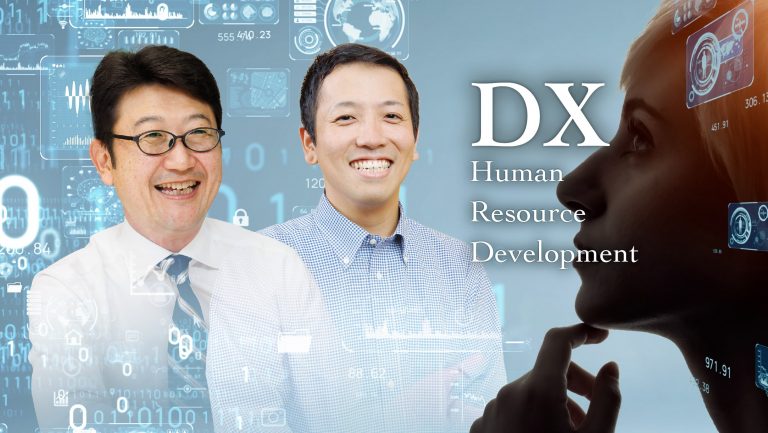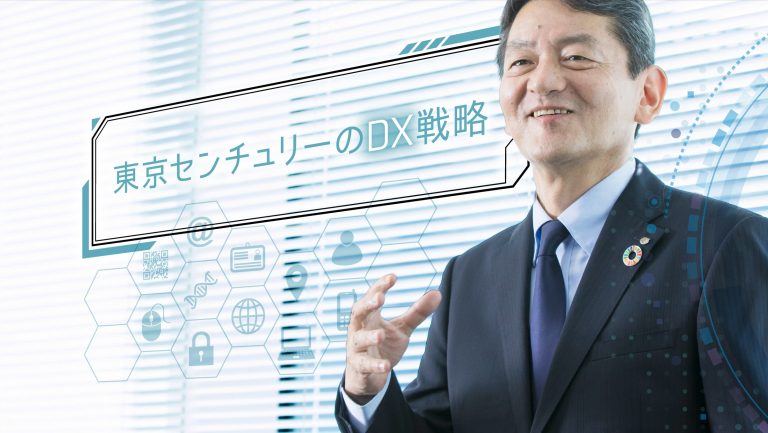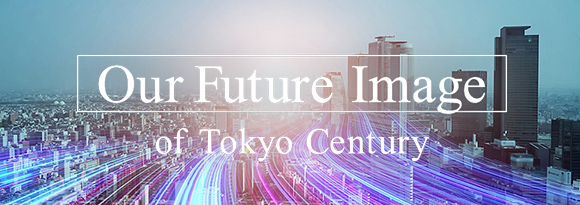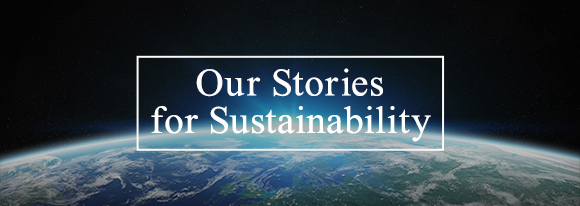
Circular Innovation for a Sustainable Future: On the Frontline of the Circular Economy
Jul 6, 2022
The “circular economy” is a concept that has pierced the public consciousness in recent years.
Long before the term came into common use, however, Japanese leasing giant Tokyo Century had already embraced a circular business model. In 2016, the company dropped the word “Leasing” from its name and began to focus on exploring business opportunities outside the leasing domain.
This article takes a look at three initiatives undertaken by Tokyo Century that exemplify its relentless pursuit of a more sustainable business model and showcase the innovation at the heart of the circular economy movement.
(NewsPicks Brand Design)
▼ INDEX

Case 01.
Supporting the Growth of a Regional Circular Economy

── What led Tokyo Century to open the Hotel Indigo Karuizawa?
Yoichiro Nakai: The opening of the Hotel Indigo represents the first stepping stone for Tokyo Century on the path to developing a full-fledged hotel business over the coming years.
── Do you have any specific plans further down that path?
The most significant milestone at present is the Tokyo Torch project, which we are working on with Mitsubishi Estate.
Tokyo Torch refers to the Tokyo Tokiwabashi Project, a major redevelopment project currently underway in the Tokiwabashi area near Tokyo Station. The centerpiece of this project is Torch Tower, a skyscraper that will become Japan’s tallest building when completed in 2027. We plan to jointly operate a luxury hotel with Mitsubishi Estate in Torch Tower once it opens.
But prior to the Hotel Indigo Karuizawa, Tokyo Century has only ever invested in hotels and does not have any operational expertise in the business. We need to build up as much knowledge and experience in hotel management as possible over the coming years so that we are fully prepared and ready to go in 2027. That’s why we decided to establish a subsidiary to manage the Hotel Indigo Karuizawa.

Yoichiro Nakai
Deputy President, Executive Officer,
President, Specialty Finance Business Unit I and Specialty Finance Business Unit II, Tokyo Century
Nakai joined The Dai-Ichi Kangyo Bank (now Mizuho Bank) in 1983, going on to serve as sales manager at Mizuho Securities and Executive Vice President at Shinsei Securities. He joined Century Tokyo Leasing (now Tokyo Century) in 2011, serving as President of the Real Estate Finance Department and Senior Managing Executive Officer, before assuming his current role in June 2022.
── Why take the risk of running your own hotels, rather than outsourcing operations as you have in the past?
We came to the conclusion that, in order to provide the greatest level of satisfaction to our customers, we needed to be engaging with them directly, be it at reception or in hotel restaurants, and not simply providing the hotel structures.
Tokyo Century as a whole is moving away from its traditional image as a leasing and financial services company. We are looking to create new markets by becoming more actively involved in the running of our businesses and services. The decision to venture into the management side of the hotel business and provide services directly to customers ourselves, rather than simply investing in hotels, comes from a desire to deliver added value to our customers.
── Why did you select the Hotel Indigo brand as a partner?
There were two reasons we chose the Hotel Indigo brand: 1) its global presence and 2) the emphasis it places on providing unique local experiences.

Karuizawa was initially developed as a European-style resort town, and Western art and culture maintain a strong presence there to this day. Designed to capture the unique character of the region, the Hotel Indigo Karuizawa locally sources as many materials as possible from within Nagano prefecture, from the wood used in its construction to the ingredients used in its kitchens. (Image: Kenjiro Yoshimi / Studio Bauhaus)
We were particularly attracted to the InterContinental Hotels Group’s Hotel Indigo brand because of the emphasis it places on incorporating local neighborhood stories into the design of its hotels, as well as the live entertainment and cuisine they offer.
Before construction began, we held in-depth discussions with the local government, as well as residents of the town, in order to get their opinions on what kind of hotel would be ideal for Karuizawa. The mayor of the town explained to us that he would like to see a hotel that contributes to the local economy by purchasing local ingredients for food and employing local residents.
As of this interview, we are currently in the pre-opening phase and already employ around 80 people. We will continue to create new jobs and recruit people from the local area, people who embody the local values that are central to Hotel Indigo’s “neighborhood stories” concept.
──There have been some cases of local communities opposing the development of large-scale hotels in areas of natural beauty like Karuizawa.
That’s true. There have been many instances of companies taking an overly aggressive approach to development in a certain area and coming into conflict with locals.
I believe it’s possible to strike a balance between a development’s disruption to the local environment and its benefits to the local economy, but it is absolutely essential to engage in careful and genuine dialogue with the local residents in order to achieve this.
The preservation of the local natural habitat is non-negotiable for the locals in Karuizawa. That is why the Hotel Indigo was constructed with a large amount of Japanese larch from Nagano prefecture, which had come to the end of its logging season, and we planted the same number of new trees as were used.

The hotel also contains a significantly reduced amount of reinforced concrete, with wood being the main material used in its construction. This not only reduced the amount of CO2 produced to manufacture the materials used in the hotel’s construction, but also reduces its carbon footprint thanks to wood’s ability to reduce emissions by removing CO2 from the atmosphere through photosynthesis.
Leveraging Existing Customer Base in Hotel Business
── Compared to its core leasing business, the Hotel Indigo Karuizawa represents a completely different challenge for the company, does it not?
It may seem that way, but the network of customers we have developed over the years in the leasing business can actually be leveraged in the hotel business, too.
For example, our hotel uniforms are designed and produced by Unico, a group company of our largest shareholder, Itochu. The linen in the hotel rooms is cleaned by another business partner of ours, Hakuyosha. Actually, Tokyo Century customers support us in all areas of the hotel business, from interior design right down to the coffee we serve.
On this new venture into the hotel management business, our core asset has been the extensive network of customers we can call upon. We have been involved in a variety of businesses from a wide range of perspectives over the years. This wealth of experience is a real advantage to us when launching a new business like this.
── Are there plans for further expansion of the hotel business?
Since the opening of Hotel Indigo Karuizawa, we have received interest from a number of companies in other regions. There is certainly abundant potential for developing more hotels that express the unique character and communicate the appeal of Japan’s various regions.
However, as I mentioned before, a deep understanding of the local region is absolutely necessary for hotels of this kind to be successful. By collaborating with residents and the local government, we can create hotels that are unique to the area and that contribute to the local community. We would be delighted to hold talks with other potential partners that share this desire for regional revitalization.

Case 02.
Adding Value by Minimizing EV Battery Waste

──What are the goals of Tokyo Century’s capital and business alliance with MIRAI-LABO?
Masato Osugi: In a nutshell, to enhance the capabilities of Tokyo Century’s automobile business.
Our Mobility & Fleet Management segment currently manages over 700,000 vehicles, but EVs account for less than 10%. We intend to boost this share as EVs become more and more commonplace.
In order for this to happen, having exit strategies in place for, say, the repurposing of used batteries, will be key. This is because exit strategies influence the residual value*, which has a considerable impact on reducing the cost of a lease.
(*) The residual value is the pre-determined estimated market value of a fixed asset (vehicle, etc.) at the end of its lease term.
Assessing lithium-ion batteries (LIBs), which account for a large share of total EV costs, and determining whether or not they can be re-used, can also be challenging. We decided to enter into the alliance with MIRAI-LABO in order to leverage its unique technology and expertise in the area of LIB assessment and reuse, which can add considerable value to our EV leases.

Masato Osugi
Managing Executive Officer,
President, Mobility Business Development Unit, Tokyo Century
Osugi joined Itochu’s Automobile Division in 1985, later becoming Head of the Division and Executive Officer in 2016. He joined Tokyo Century in 2019 and assumed his current roles of Managing Executive Officer and President of Tokyo Century’s Mobility Business Development Unit, as well as Executive Vice President of Nippon Car Solutions, in 2020.
── What are the current challenges when it comes to reusing Lithium Ion Batteries?
One issue is the fact that there are still relatively few EVs being used. The lack of an established business model for the collection, assessment, and recirculation of used LIBs is another.
LIBs actually have a wide range of potential uses, such as energy storage, even after they are no longer fit for use in a vehicle.
── So you’ve teamed up with MIRAI-LABO to improve your assessment of used LIBs?
That’s right. If a battery’s capacity falls to around 70─80%, it’s usually not suitable for use in vehicles after that. MIRAI-LABO can assess LIBs that have deteriorated to a certain point on an even more detailed, modular level.
Depending on the degree of deterioration, EV batteries can be repurposed as stationary storage batteries or batteries for street lighting. Rare metals can also be recovered from those that have deteriorated considerably, further reducing waste and increasing the value provided by LIBs over their lifetime.
Accurate Assessments and Diverse Channels
── So, what you’re saying is EVs are supposed to be environmentally friendly, but their batteries are not actually being utilized to their fullest.
We do unfortunately hear of large amounts of deteriorated LIBs taking up space in manufacturers’ warehouses. They simply cannot find any use for them.

This is a real waste given the scarcity of LIBs and the many ways in which they can be reused. Ideally, LIBs should be recirculated in the market as soon as possible, because piles of improperly discarded LIBs can ignite and cause fires.
MIRAI-LABO has extensive knowledge and expertise on the proper handling of LIBs. By combining this knowledge with our business network here at Tokyo Century, I am convinced that we can create a virtuous circle whereby MIRAI-LABO uses its expertise to identify potential uses for LIBs, and we provide the network for their recirculation in the market. We intend to leverage MIRAI-LABO’s technologies going forward to better meet the evolving needs of our customers.

──How will the reuse of LIBs help your business to expand?
The reuse of LIBs will be crucial to strengthening our EV business. The ability to draw up exit strategies allows us to offer our customers EV leases at an appropriate cost, which can help us to further expand the business.
It represents a starting point for further developments in energy management, including charging services and electricity balancing markets.
By expanding the range of services offered during the lease period, we can also gain a better understanding of market needs and provide greater value to our customers.
Outside of vehicle leasing, Tokyo Century has close ties with companies in a wide range of other fields. The scale of our network gives us the potential to expand the reuse of LIBs. They could be repurposed in other products or used as storage batteries in solar power plants. The potential scope is huge.

── This seems to be a critical juncture for the company.
Our business has traditionally been product-oriented, with a focus on automobiles. In order to remain competitive going forward, though, we believe it will be necessary to shift to a more customer-oriented business model by leveraging our extensive customer base in the automobile sector.
We need to move on from our outdated concept of the mobility business and create added value through IT and DX (digital transformation) that meets the evolving needs of our customers, all the while keeping environmental concerns top of mind. Collaborating with MIRAI-LABO on the assessment and reuse of LIBs is just the beginning of this transformation. We will continue to leverage our network to seek out and take on new challenges.

Case 03.
Biodiversity Banking: Using Market Principles to Protect Rural Ecosystems

── Tokyo Century began collaborating on a new conservation project last year─ Tsubaki TC Satoyama Bank. Could you tell us a little about this project?
Koichi Nakajima: Sure. The project is targeting satoyama in and around the town of Shisui, Chiba prefecture, and is the first attempt at biodiversity banking in Japan. Biodiversity banking refers to a mechanism by which the negative effects of economic activities on biodiversity are offset or compensated for by conservation activities.
The reality is that economic activities, including our own businesses, have a significant impact on the environment, be it through greenhouse gas emissions or deforestation. Satoyama banking represents a way for businesses to counteract the harmful effects their activities can have on the environment.

Koichi Nakajima
Executive Fellow, Tokyo Century
Nakajima joined The Dai-Ichi Kangyo Bank (now Mizuho Bank) in 1976, going on to serve as Executive Officer of Mizuho Bank and Managing Executive Officer of Mizuho Securities before joining Century Tokyo Leasing (now Tokyo Century) in 2009. As Deputy President, Director and Executive Officer, he established and oversaw the growth of the Specialty Finance Business Unit, focusing on ships, aircraft, and real estate. He assumed his current role in April 2021.
The concept of biodiversity offsets is already well-established in other developed countries. If you want to build a factory, for example, but the local environment is home to endangered species, you’re unlikely to get permission. But if a similar environment can be created elsewhere, there’s a chance that permission will be granted if you commit to paying for the development of that environment.
The US has already formulated legislation in this area, and there are companies that specialize in environmental restoration. It has become a viable business.
── It seems like a very worthwhile venture, but what attracted a leasing company like Tokyo Century to get involved?
We believe that the leasing industry and environmental conservation are similar in that they both play a role in driving the creation of a circular economy.
── Could you elaborate on that?
Leasing is not simply about renting things out to people. We oversee the entire life cycles of the products we lease out, from initial purchase right through to their reuse or disposal. In many ways, it is a business model that embodies the circular economy.
Take aircraft for example. The aircraft we lease to airlines are often repurposed as cargo aircraft when they are no longer used as passenger aircraft. In such cases, the passenger seats and other equipment that is no longer required are removed and reused. Even parts of retired aircraft are often reused. The same applies to the computers and mobile phones we lease to companies.
Take away one part of this cycle and it no longer functions properly. Just like an ecosystem.

── So the leasing business and ecosystems are both cyclical in nature. What impact does Tokyo Century’s business have on the environment?
Well, Tokyo Century is involved with around 700,000 vehicles, 100 ships, and over 400 aircraft. Naturally, these emit harmful greenhouse gases.
Renewable energy is another core business for Tokyo Century, and we currently operate more than 100 solar power plants across Japan. We’re always looking for ways to minimize the environmental impact of these plants by, for example, using floating solar panels on bodies of water. But inevitably a certain amount of land needs to be cleared in order to construct them.

Despite adopting a management philosophy that aims to contribute to the creation of an environmentally sound, sustainable economy and society, there was still a feeling in the company that we could do more to limit our impact on ecosystems.
It was around this time that I was introduced to Dr. Akira Tanaka from the Department of Restoration Ecology and Built Environment at Tokyo City University. He’s a leading advocate for biodiversity banking in Japan.
After we met, I visited the town of Shisui in Chiba, where I saw Tsubaki Farm and the satoyama that the project is trying to protect with my own eyes. That’s when I decided that Tokyo Century should be part of this project.

A Sustainable Mechanism Intertwined with the Business World
── What threats do Japan’s satoyama face today?
Many satoyama in rural areas of Japan are in critical condition. Abandoned bamboo forests have become overgrown and are hindering the growth of other species that make up the forest undergrowth. The traditional satoyama landscape is disappearing as a result.
The dwindling and aging population of rural areas, as well as the increasing number of modern conveniences such as convenience stores, means that some satoyama are not being properly maintained and are falling into disrepair. This is leading to the collapse of traditional ecosystems.
──So you think companies should step in and protect these ecosystems. Is this satoyama project part of your CSR activities?
That’s correct. The project is part of our efforts to contribute to the creation of an environmentally sound, sustainable economy and society─our management philosophy. That being said, we will be looking to commercialize it in the future as there are limits to what we can achieve on our own in terms of environmental conservation.
Dr. Tanaka is also of the opinion that economic incentives will be essential to ensure the long-term protection of biodiversity. It’s that kind of thinking that convinced us to collaborate on this project.
So how do we commercialize our efforts in this area? What kind of companies should we collaborate with? These are the kinds of questions we’re currently exploring.
As a first step, we’re looking to use our network of partners to establish an organization dedicated to popularizing the concept of biodiversity banking in Japan.

Our customers include many of Japan’s leading corporations. We want to spread awareness of biodiversity banking among these companies and get them fully on board with the concept. We also believe it will be necessary to lobby the government to enact appropriate legislation in this area.
This joint research project with Tsubaki Farm is just the first step. We want to find ways to get as many companies as possible involved in these kinds of activities.
It’s getting harder and harder for companies to ignore the issue of environmental protection. We hope that our partners will join us in our efforts to create a mechanism for greater sustainability that is embraced across the business community.
*The contents of the article and the position titles are as of the date posted.
RECOMMEND ARTICLES
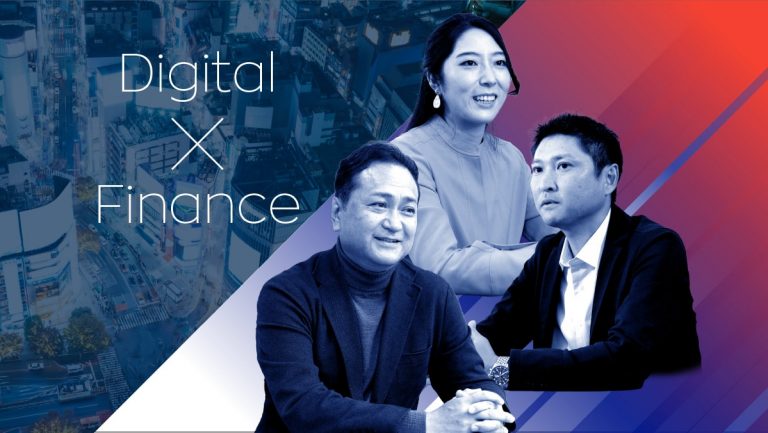
Feb 1, 2023
A collaboration was …
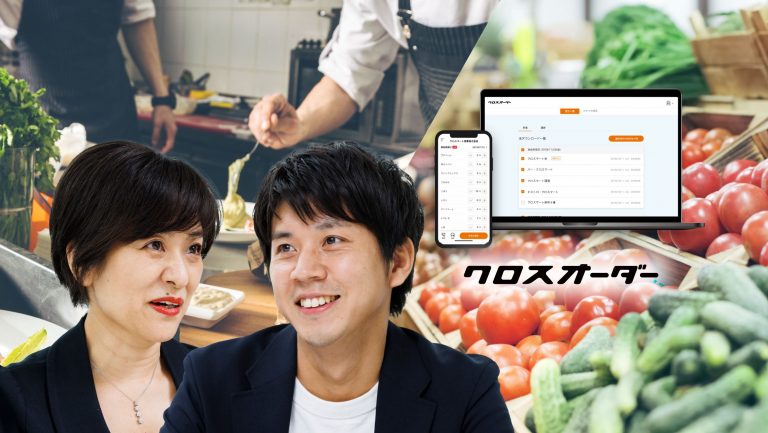
ーWorking with XMart to Innovate Order and Supply Operations in the Food Distribution Industry
Aug 24, 2022
In March 2022, Tokyo…



